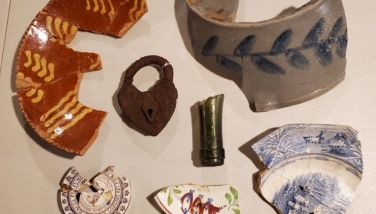Petite Exhibit: Pottery, Glass and Iron: Excavated Corbit Trash
In 2020, during an Historic Odessa Foundation archaeological dig led by HOF Volunteer Archeologist John Bansch, part of an old trash dump was found on the grounds of the National Historic Landmark Corbit-Sharp House.
The artifacts from this trash dump date from about 1810-1870, during the period when Daniel Corbit’s family and servants lived at the site. In this petite exhibit, Pottery, Glass and Iron: Excavated Corbit Trash, discover what Daniel's family was throwing away over 150 years ago! How was this different from what we throw away today?
Archaeologists refer to these time capsules of history as “trash middens”. They estimated that this 4'x6' archaeological test unit exposed about 20% of the total trash midden. The test unit was packed with nearly 2,500 broken historical artifacts that were mixed in with over 500 oyster shells. The artifacts included 1,893 ceramic sherds, 319 sherds of glass, and 260 other miscellaneous artifacts including nails, iron objects, and animal bones.
Excluding the oyster shells and four red bricks, the total weight of the recovered artifacts was 79 pounds. The archeologists were astonished to discover that 489 of the broken pottery and glass sherds could be "mended" together with archival glue to partially recreate some 50 different types of identifiable objects, 30 of which are on display. Archeologists identified 275 different ceramic and glass vessel types that were recovered from this test unit. Each artifact was numbered, catalogued and identified through research and experience.
This HOF petite exhibit includes some of the mended "vessels" (different plates, bowls, jars, and bottles) and some of the iron objects that were excavated from this fascinating trash midden. Come and investigate the wide variety of artifacts for yourself at the Historic Odessa Foundation.
This petite exhibit is included with general HOF admission.



